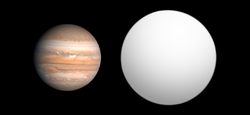Astronomy:WASP-4b
 Size comparison of WASP-4b with Jupiter. | |
| Discovery[1] | |
|---|---|
| Discovered by | Wide Angle Search for Planets |
| Discovery site | South African Astronomical Observatory |
| Discovery date | October 31, 2007 |
| Transit photometry | |
| Orbital characteristics[3] | |
| 0.02239±0.00084 astronomical unit|AU | |
| Eccentricity | <0.0033[2] |
| Orbital period | 1.338231587(22) d |
| Inclination | 88.02°±0.69° |
| Semi-amplitude | 232.7+2.5 −2.2 m/s[2] |
| Star | WASP-4 |
| Physical characteristics[3] | |
| Mean radius | 1.312±0.045 RJ |
| Mass | 1.164±0.082 Jupiter mass |
| Mean density | 0.639±0.079 g/cm3 |
| Physics | 1957±68 K (1,684 °C; 3,063 °F)[4] |
WASP-4b is an exoplanet, specifically a hot Jupiter, approximately 891 light-years away[5] in the constellation of Phoenix.[6]
Discovery
The planet was the discovered by the Wide Angle Search for Planets team using images taken with the SuperWASP-South project's eight wide-angle cameras located at the South African Astronomical Observatory.[7][8][1] Analysis of over 4000 images taken between May and November 2006 resulted in the detection of a transit occurring every 1.3 days. Follow-up radial velocity observations using the Swiss 1.2-metre Leonhard Euler Telescope confirmed that the transiting object was a planet.[1]
Characteristics
The planetary equilibrium temperature would be 1650±30 K,[9] but the measured dayside temperature is higher, with a 2015 study finding 1900±100 K[10] and a 2020 study finding 1957±68 K.[4]
A study in 2012, utilizing the Rossiter–McLaughlin effect, determined the planetary orbit is probably aligned with the equatorial plane of the star, with misalignment equal to -1+14−12°.[11]
The planet's orbital period appears to be decreasing at a rate of 7.33±0.71 milliseconds per year, suggesting that its orbit is decaying, with a decay timescale of 15.77±1.57 million years. The anomalously high rate of orbital decay of WASP-4b is poorly understood as of 2021.[3]
References
- ↑ 1.0 1.1 1.2 Wilson, D. M. et al. (2008). "WASP-4b: A 12th Magnitude Transiting Hot Jupiter in the Southern Hemisphere". The Astrophysical Journal Letters 675 (2): L113–L116. doi:10.1086/586735. Bibcode: 2008ApJ...675L.113W.
- ↑ 2.0 2.1 Bonomo, A. S. et al. (June 2017). "The GAPS Programme with HARPS-N at TNG. XIV. Investigating giant planet migration history via improved eccentricity and mass determination for 231 transiting planets". Astronomy & Astrophysics 602: A107. doi:10.1051/0004-6361/201629882. Bibcode: 2017A&A...602A.107B.
- ↑ 3.0 3.1 3.2 Turner, Jake D.; Flagg, Laura; Ridden-Harper, Andrew; Jayawardhana, Ray (2022), "Characterizing the WASP-4 System with TESS and Radial Velocity Data: Constraints on the Cause of the Hot Jupiter's Changing Orbit and Evidence of an Outer Planet", The Astronomical Journal 163 (6): 281, doi:10.3847/1538-3881/ac686f, Bibcode: 2022AJ....163..281T
- ↑ 4.0 4.1 Wong, Ian; Shporer, Avi; Daylan, Tansu; Benneke, Björn; Fetherolf, Tara; Kane, Stephen R.; Ricker, George R.; Vanderspek, Roland et al. (2020), "Systematic Phase Curve Study of Known Transiting Systems from Year One of the TESS Mission", The Astronomical Journal 160 (4): 155, doi:10.3847/1538-3881/ababad, Bibcode: 2020AJ....160..155W
- ↑ Vallenari, A. et al. (2022). "Gaia Data Release 3. Summary of the content and survey properties". Astronomy & Astrophysics. doi:10.1051/0004-6361/202243940 Gaia DR3 record for this source at VizieR.
- ↑ Roman, Nancy G. (1987). "Identification of a Constellation From a Position". Publications of the Astronomical Society of the Pacific 99 (617): 695–699. doi:10.1086/132034. Bibcode: 1987PASP...99..695R. Vizier query form
- ↑ Sherriff, Lucy (2007-10-31). "UK boffins ID three new exo-planets". The Register. https://www.theregister.co.uk/2007/10/31/superwasp_planets/.
- ↑ "Astronomer discovers new planets". BBC News. 2007-10-31. http://news.bbc.co.uk/2/hi/uk_news/scotland/edinburgh_and_east/7070887.stm.
- ↑ Table 3, Improved parameters for the transiting hot Jupiters WASP-4b and WASP-5b, M. Gillon et al., Astronomy and Astrophysics 496, #1 (2009), pp. 259–267, doi:10.1051/0004-6361:200810929, Bibcode: 2009A&A...496..259G.
- ↑ Zhou, G.; Bayliss, D. D. R.; Kedziora-Chudczer, L.; Tinney, C. G.; Bailey, J.; Salter, G.; Rodriguez, J. (2015). "Secondary eclipse observations for seven hot-Jupiters from the Anglo-Australian Telescope". Monthly Notices of the Royal Astronomical Society 454 (3): 3002–3019. doi:10.1093/mnras/stv2138. Bibcode: 2015MNRAS.454.3002Z.
- ↑ Albrecht, Simon; Winn, Joshua N.; Johnson, John A.; Howard, Andrew W.; Marcy, Geoffrey W.; Butler, R. Paul; Arriagada, Pamela; Crane, Jeffrey D. et al. (2012), "Obliquities of Hot Jupiter Host Stars: Evidence for Tidal Interactions and Primordial Misalignments", The Astrophysical Journal 757 (1): 18, doi:10.1088/0004-637X/757/1/18, Bibcode: 2012ApJ...757...18A
Further reading
- Petrucci, R. et al. (2013). "No Transit Timing Variations in Wasp-4". The Astrophysical Journal Letters 779 (2): L23. doi:10.1088/2041-8205/779/2/L23. Bibcode: 2013ApJ...779L..23P.
- Huitson, C. M. et al. (2017). "Gemini/GMOS Transmission Spectral Survey: Complete Optical Transmission Spectrum of the Hot Jupiter WASP-4b". The Astronomical Journal 154 (3): 95. doi:10.3847/1538-3881/aa7f72. Bibcode: 2017AJ....154...95H.
- Bouma, L. G. et al. (June 2019). "WASP-4b Arrived Early for the TESS Mission". The Astronomical Journal 157 (6): 217. doi:10.3847/1538-3881/ab189f. Bibcode: 2019AJ....157..217B.
External links
- "Transiting exoplanets from the Wide Angle Search for Planets". Coel Hellier. https://wasp-planets.net/.
- "UK planet hunters announce three new finds". 2007-10-30. http://www.superwasp.org/press_release2/WASP2007_national_pressV5.pdf.
Coordinates: ![]() 23h 34m 15.06s, −42° 03′ 41.1″
23h 34m 15.06s, −42° 03′ 41.1″
 |


